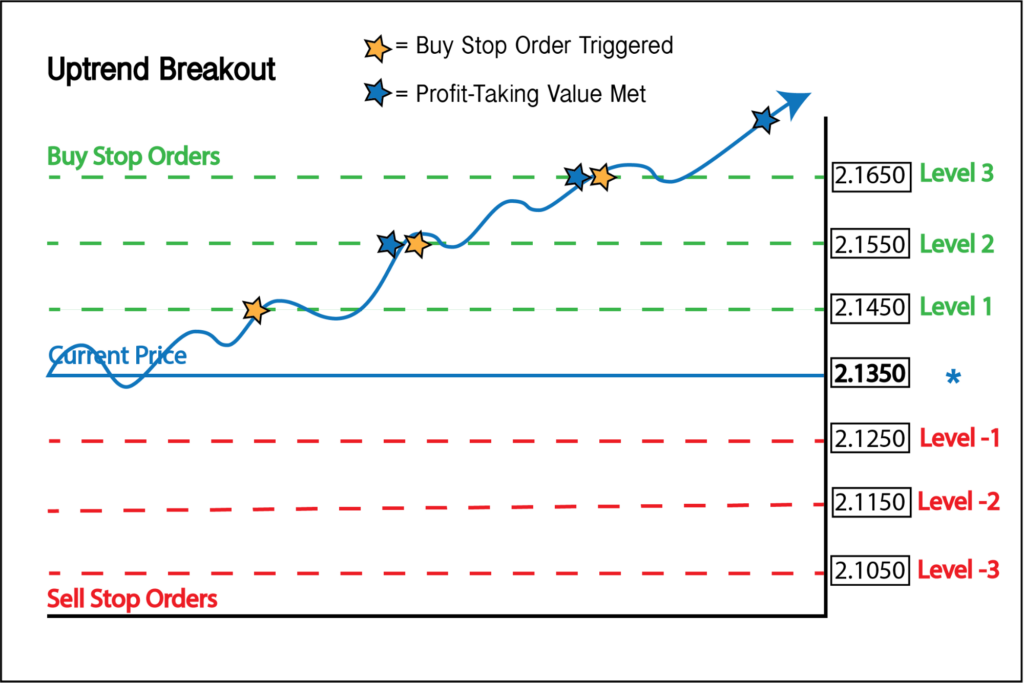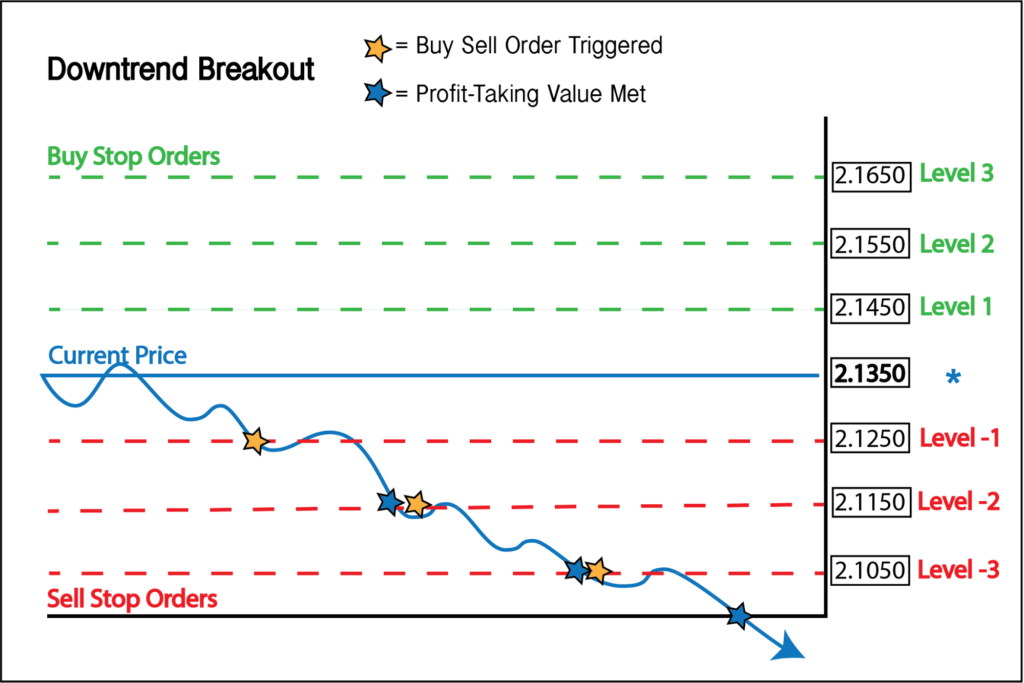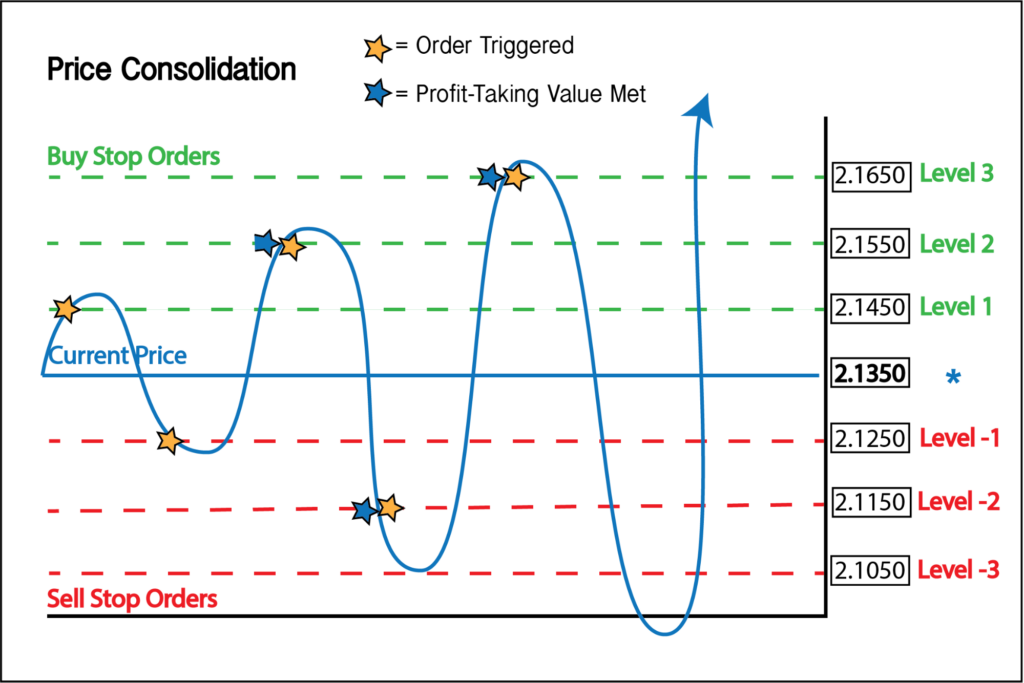The Forex Grid System has grown in popularity among traders since it is easy to understand and has several key advantages at first glance. It’s a kind of automatic approach that uses buy and sell stop orders to take the worry out of trading. Even in volatile market conditions, it might provide trading opportunities.
As a result, there is no need to forecast market direction. This method works well in sideways markets where there is no significant trend up or down. It is ideal for short timeframes because it does not rely on significant price swings.
What is grid trading?
Grid trading is when orders are put above and below a predetermined price creating a grid of orders with incrementally increasing and decreasing prices. Buy stop entry orders are set above the current market price in a grid trading technique.
If a bullish breakout occurs, these orders will instantly place you into a long position. In the case of a bearish breakout, sell stop entry orders are placed below the current market price to initiate a short position. As a result, your account for all conceivable breakout possibilities and ensure that a pending order will be activated to enter the market regardless of the trend’s direction.
How to set up the grid
Below is the list of all of the elements of the grid and how to set them up.
- Make a grid with an upper-bound (strong resistance) and a lower-bound (strong support).
- The grid lines between the support and resistance zones should be evenly spaced. (Anywhere from 5 to 10 grid lines can be used).
- Determine the gridlines that are closest to the current price, both above and below it (ignoring the very closest grid line).
- Buy and recalculate near gridlines if price crosses beneath a near gridline.
- Sell and recalculate close gridlines if the price crosses over a near gridline.
- A FIFO (First in, First out) mechanism is used to enter and exit trades. So, if the price declines three grid lines (buy-1, buy-2, and buy-3) before crossing above one grid line, only the first transaction will be closed (sell-1). It will enter a new trade (buy-4) if it falls again, and it will sell the original second trade if it crosses above again (sell-2). The number of trades you can do at once is determined by the number of grid lines you have.
Example of grid trading in GBPUSD
Let’s assume you notice the GBPUSD is trading in a range of 1.3700 to 1.3800. Because the price is currently approaching 1.3750, you decide to utilize a 10 pip interval against the trend grid to profit from the range.
Enter a sell order at 1.3760, 1.3770, 1.3780, 1.3790, 1.3800, and 1.3810. Place a stop loss at 1.3830. This ensures that the risk is limited. If all sell orders are triggered, no grid purchase orders are triggered, and the stop-loss is hit, the risk is 270 pips.
Place a buy order at 1.3740, 1.3730, 1.3720, 1.3710, 1.3700, and 1.3690. Place a stop loss at 1.3670. The potential risk is 270 pips. If all of the buy orders are triggered, no grid sell orders are activated, and the stop loss is reached, the trade is considered closed.
Within the range of 1.3810 and 1.3690, you expect the price to move higher and lower or lower and higher. Hoping that the price doesn’t move too much outside of that range since if it does, you’ll have to take a loss to keep the risk under control.
Outcomes of grid trading
The success of grid trading is mostly dependent on price action. Price will inevitably break out of its present support and resistance band in a trending market and move in one direction for an extended period of time.
Let’s look at the ways to enter and exit the market using the grid in the charts below.


In an ideal scenario, the price will rise or fall in one direction without swinging, fulfilling all of your orders and allowing you to benefit in a timely manner. This will cause a perfect uptrend and downtrend breakthrough situation.
Price consolidation
Chaotic price fluctuation will cause all of the entry orders to be opened, and all of the take-profit points will be hit.

In this scenario, keeping track of your net gains and losses is critical to determining when the approach should be abandoned.
Reversal
Price may break out in one way before reversing and leaving an open position in the opposite direction.

In this case, we’ll be attempting to profit from the downtrend.
Advantages and disadvantages
Let’s look at some pros and cons of grid trading in the list below.
Advantages
- Grid trading enhances the size of your position. You won’t have to risk a huge portion of your cash on a single trade, and you’ll be able to scale in and out of positions.
- You may profit from both trending and consolidating markets when you use a pure trading grid.
- It’s simple to automate and leave running without too much involvement. Simply communicate your order levels to your broker and let the technology work its magic. Other trading tactics necessitate more skill and administration.
- It is simple to comprehend. In terms of algorithms or technical indicators, the plan does not necessitate anything. It is straightforward to comprehend and operate.
- Because you’ll have many entries at different levels, you’ll be less likely to be taken out of the market during huge price swings.
Disadvantages
- Your entries and exits may not be away from your designated levels in a fast-moving market with a lot of volatility, which could cause issues with risk/reward parameters and the grid itself.
- There is a strong desire to cash in on gains as soon as possible. Grid trading is all about riding the market’s wave. If you take too much money off the table too soon, your losing trades will be greater, resulting in a greater loss.
- If markets are consolidating, you may have to pay a lot in exchange costs. If you set up your grid system and one or more of your orders are filled, but the market does not move significantly for a long time, you might find yourself holding many orders for a long time. It indicates you’ll have to pay overnight fees.
Conclusion
The grid system is unique among trading strategies in that it is better suited to trade in volatile markets, particularly those with sideways movement. It’s simple to learn and implement, and it doesn’t necessitate any advanced analytical abilities. There are four outcomes of grid trading, uptrend breakout, downtrend breakout, price consolidation, and reversal. As with other trading strategies, grid trading has advantages and disadvantages.




